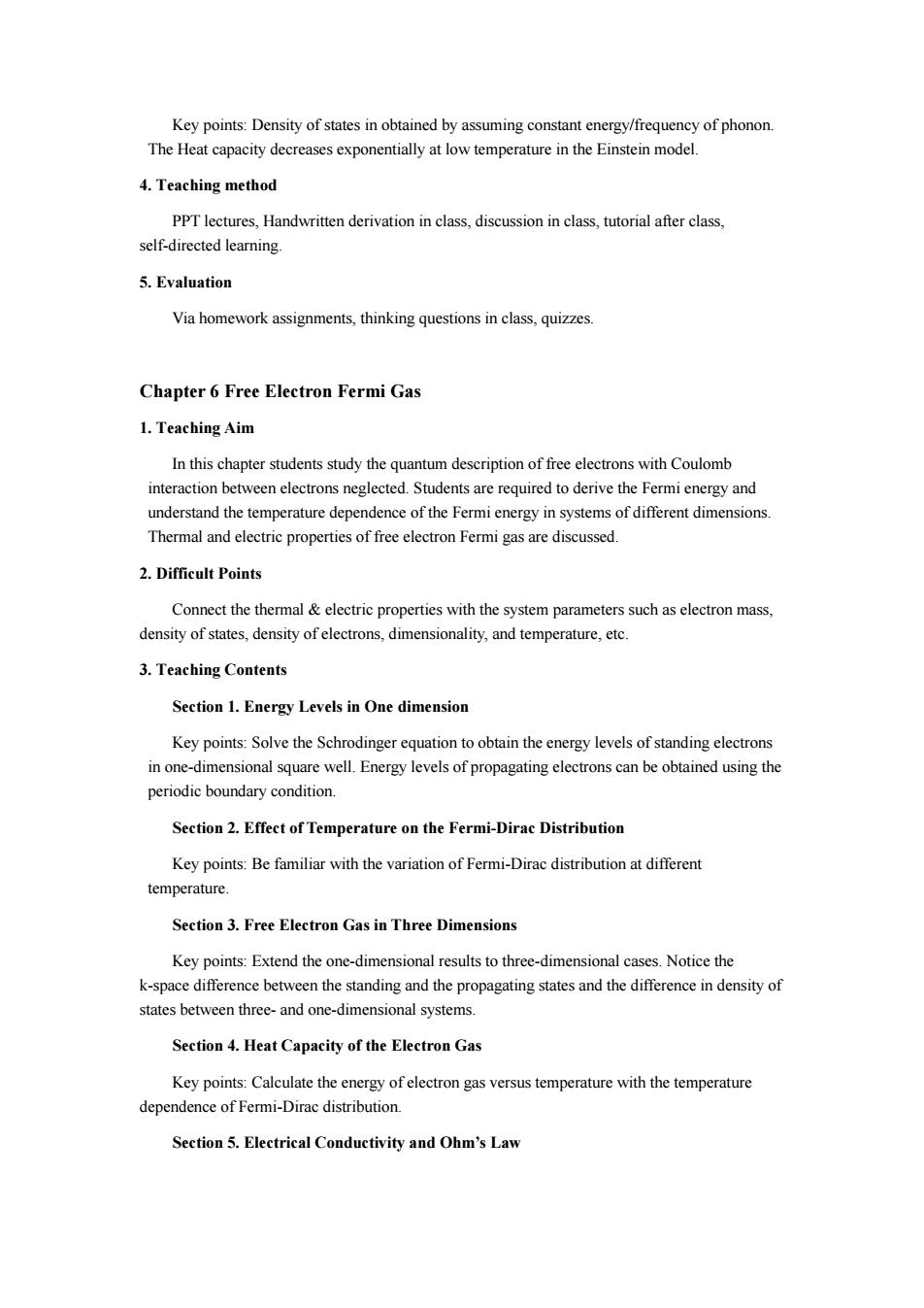正在加载图片...

Key points:Density of states in obtained by assuming constant energy/frequency of phonon. The Heat capacity decreases exponentially at low temperature in the Ein odel 4.Teaching method PPT lectures.Handwritten derivation in class.discussion in class.tutorial after class. self-directed learning. 5.Evaluation Via homework assignments,thinking questions in class,quizzes. Chapter 6 Free Electron Fermi Gas 1.Teaching Aim In this chapter students study the quantum description of free electrons with Coulomb interaction between electrons neglected.Students are required to derive the Fermi energy and understand the temperature dependence of the Fermi energy in systems of different dimensions Thermal properties of Fermi gas are discussed. 2.Difficult Points Connect the thermal&electric properties with the system parameters such as electron mass. density of states,density ofelectrons,dimensionality,and temperature,etc. 3.Teaching Contents Section 1.Energy Levels in One dimension Key points:Solve the Schrodinger equation to obtain the energy levels of standing electrons in one-dimensional square well.Energy levels of propagating electrons can be obtained using the periodic boundary condition. Section 2.Effect of Temperature on the Fermi-Dirac Distribution Key points:Be familiar with the variation of Fermi-Dirac distribution at different temperature. Section 3.Free Electron Gas in Three Dimensions Key points:Extend the one-dimensional results to three-dimensional cases.Notice the k-space difference between the standing and the propagating states and the difference in density of states between three-and one-dimensional systems. Section 4.Heat Capacity of the Electron Gas Key points:Calculate the energy of electron gas versus temperature with the temperature dependence of Fermi-Dirac distribution. Section 5.Electrical Conductivity and Ohm's LawKey points: Density of states in obtained by assuming constant energy/frequency of phonon. The Heat capacity decreases exponentially at low temperature in the Einstein model. 4. Teaching method PPT lectures, Handwritten derivation in class, discussion in class, tutorial after class, self-directed learning. 5. Evaluation Via homework assignments, thinking questions in class, quizzes. Chapter 6 Free Electron Fermi Gas 1. Teaching Aim In this chapter students study the quantum description of free electrons with Coulomb interaction between electrons neglected. Students are required to derive the Fermi energy and understand the temperature dependence of the Fermi energy in systems of different dimensions. Thermal and electric properties of free electron Fermi gas are discussed. 2. Difficult Points Connect the thermal & electric properties with the system parameters such as electron mass, density of states, density of electrons, dimensionality, and temperature, etc. 3. Teaching Contents Section 1. Energy Levels in One dimension Key points: Solve the Schrodinger equation to obtain the energy levels of standing electrons in one-dimensional square well. Energy levels of propagating electrons can be obtained using the periodic boundary condition. Section 2. Effect of Temperature on the Fermi-Dirac Distribution Key points: Be familiar with the variation of Fermi-Dirac distribution at different temperature. Section 3. Free Electron Gas in Three Dimensions Key points: Extend the one-dimensional results to three-dimensional cases. Notice the k-space difference between the standing and the propagating states and the difference in density of states between three- and one-dimensional systems. Section 4. Heat Capacity of the Electron Gas Key points: Calculate the energy of electron gas versus temperature with the temperature dependence of Fermi-Dirac distribution. Section 5. Electrical Conductivity and Ohm’s Law